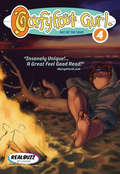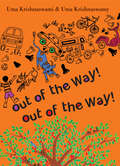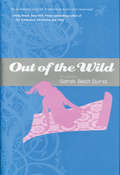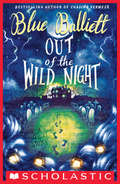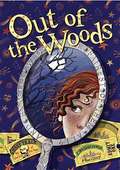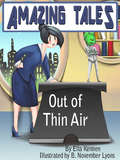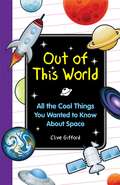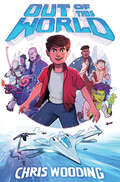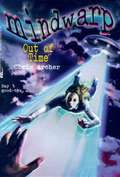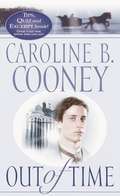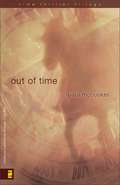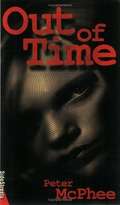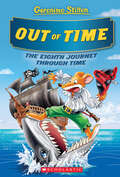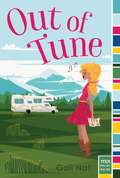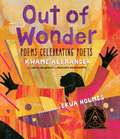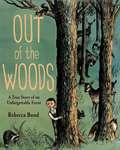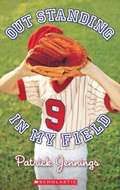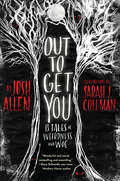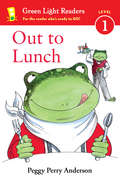- Table View
- List View
Out of the Soup
by Realbuzz StudiosFor Suki, all's fair in love and surfing.It's peace, love, and fierce competition at the local Surf and Sand Contest. Trouble is brewing on the water for surf rivals Scott and Ray, while Suki learns more than she expects about surfing--and romance--from her new mystery man.
Out of the Way! Out of the Way!
by Uma KrishnaswamiSelected for the USBBY Outstanding International Book List A young boy spots a baby tree growing in the middle of a dusty path in his village. He carefully places rocks around it as the local mango seller rushes past shouting, "Out of the way! Out of the way!" As the tree grows bigger, people and animals traverse the path until it becomes a lane, flowing like a river around the tree— getting out of its way. Over time, the lane becomes a road, and a young man crossing the road with his children remembers the baby tree from long ago. By the time he is an old man, the tree has become a giant. The city traffic continues to rattle past, noisier and busier than ever, but sometimes the great tree works its magic, and people just stop, and listen. In this simple, lyrical story, a wide-spreading tree and a busy road grow simultaneously, even as time passes and the footsteps of people and animals give way to speeding cars, buses and trucks. The illustrations, in pen-and-ink with vibrant blocks of color, have a classic folk-art feel. The author and illustrator, who really do share the same name (except for the last letter!), have always wanted to do a book together. Correlates to the Common Core State Standards in English Language Arts:CCSS.ELA-LITERACY.RL.K.2With prompting and support, retell familiar stories, including key details.CCSS.ELA-LITERACY.RL.1.7Use illustrations and details in a story to describe its characters, setting, or events.CCSS.ELA-LITERACY.RL.2.5Describe the overall structure of a story, including describing how the beginning introduces the story and the ending concludes the action.
Out of the Wild
by Durst Sarah BethBeware the Wild-it bites. Ever since Julie Marchen helped defeat the fairytale world of the Wild, life's been pretty much back to normal. That is, as normal as life can be for a girl whose mom is Rapunzel. Yes, that Rapunzel. Then the Wild mysteriously releases Zel's prince (Julie's dad!)-a rescue-minded hero who crashes full-speed ahead into the 21st century! (YOU try teaching a 500-year-old prince to use a seatbelt. ) Julie's over the moon, but when a wicked Fairy Godmother kidnaps Sleeping Beauty and reawakens the Wild, Julie and her dad set off on an action-packed adventure to save the distressed damsel. . . and the world. If they can't, they'll spend eternity in a fairytale.
Out of the Wild
by Sarah Beth DurstEver since twelve-year-old Julie Marchen helped defeat the fairy-tale world of the Wild, life's been about as normal as it can be, for a girl whose brother is Puss-in-Boots and whose mom is Rapunzel. After nearly taking over her hometown, the Wild is safely back where it belongs: right under Julie's bed. Then it suddenly spits out Julie's dad--Rapunzel's prince--and things take a seriously enchanted turn. He's gallant, he's handsome, and he's totally clueless about life in the 21st century! (You try teaching a five-hundred year old prince how to text message.) When Julie's daring dad dashes off to save a kidnapped Sleeping Beauty, she must embark on a magical cross-country adventure to bring him home, protect the family secret, and while she's at it, save the world! Because if she fails, everyone will spend eternity in a fairy tale.
Out of the Wild Night (Scholastic Press Novels)
by Blue BalliettFrom the New York Times bestselling author of Chasing Vemeer an unforgettable story about an island haunted by the past . . . and the ghosts who must help with the present.Ghosts are alive on the island of Nantucket. You can hear them in the wind, and in the creaks of the old homes. They want to be remembered. And, even more, they want to protect what was once theirs. The ghosts seem to have chosen a few local kids to be their messengers -- and to help save the island. But in this mystery, the line between those who haunt and those who are haunted is a thin one -- and the past and the present must come to terms with one another in order to secure the future.
Out of the Woods: A True Story of an Unforgettable Event (Into Reading, Read Aloud Module 9 #3)
by Rebecca BondNIMAC-sourced textbook
Out of the Woods
by Lyn GardnerThe fun fair is in town! With its clouds of pink candyfloss and whirling big wheel, what child could resist such temptation? Little do the Eden sisters know that they are being lured into a wicked witch's lair . . . Barely escaping from a deadly game of hide-and-seek in the enchanted fair, our three heroines flee through the woods, with several ravenous wolves and a sweet-toothed lion hot on their heels. But now they face their biggest challenge yet. Will the Eden sisters ever truly be out of the woods?
Out of Thin Air
by Ella KennenWhen Evelina Miller's father gets a little "creative" on Evelina's boarding school application, she finds herself locked in a warehouse with orders to spin oxygen out of the thin air of space. A mysterious alien appears and agrees to help her, but only for a steep price. Versions of the classic fairy tale Rumpelstiltskin have been thrilling children at bedtime since the Grimm Brothers included it in their first anthology 200 years ago. You and your child will snuggle up to this future classic – with its clever twist ending -- night after night.
Out of this World
by Clive GiffordAre you baffled by the Big Bang? Curious about what it's like to walk on the moon? Wondering if someday you might meet an alien? Dreaming of becoming an astronaut? This fun, comprehensive book is bursting with all the cool things you ever wanted to know about space. In Out of Space you will discover . . .· The Earth, the Moon, and in Between--From the birth of our planet and its fascinating blueprint to its amazing atmosphere and our nearest neighbor, the moon!· Earth's Neighborhood--From the eight planets in our solar system and the characteristics that set them apart to the mystifying facts about comets and meteoroids.· Seething Stars and Giant Galaxies--From the life of the star and its various sizes and shapes to the 200 billion that make up the Milky Way.· Stargazing--From the accounts and theories of the ancient astronomers to today's scientists and their search for the extraterrestrial.· Exploring Space--From the first-known rockets to today's mighty spacecraft and the famous missions that advanced our exploration.· How It All Began . . . and Might End--From scientists' theories about the dawn of time to the fierce debate about how, when--and if--the universe may end someday.
Out of This World
by Chris WoodingThe Hitchhiker's Guide to the Galaxy meets Guardians of the Galaxy in this intergalactic middle-grade adventure by Chris Wooding.If he had it his way, Jack would spend his days drawing aliens and epic space battles. But it seems Jack's daydreams of action and adventure will remain just that: daydreams.Until his 12th birthday, that is. That's when Thomas, the annoying kid from school, stumbles upon a weird machine that sends a beam of light into the sky. Suddenly, Jack's world is turned upside down when intergalactic beings appear on Earth and try to kill him. His only hope for survival is a ragtag team of alien bounty hunters: Boston Sark, Mazzy, Dunk, and Ilara. Through his new companions, Jack learns of the mysterious Gradius Clench, a precocious superspy and the universe's most wanted kid. And he looks just like Jack! Now, the race is on to find this elusive Gradius Clench -- through fantastic landscapes, seedy pirate hideaways, and worlds Jack could only imagine -- and maybe, just maybe, figure out how Jack fits into all of this...
Out of This World: Poems and Facts about Space
by Amy SklanskyAmy Sklansky and Stacey Schuett give young explorers the moon and stars and beyond! The mysteries of the universe and the science of space exploration are perennialy popular subjects, and Out of This World is a wonderful introduction. Amy Sklansky has written evocative poems about planets and stars and rockets and moon landings and satellites. Each poem is supported by additional facts and explanations in the margins. Stacey Schuett brings it all to life with color-soaked skies and beautiful perspectives in her fabulous paintings. Space is a subject too grand for poetry or prose alone, so this book offers both to help readers truly appreciate our place in space.
An Out-of-This-World Vacation (Fountas & Pinnell LLI Gold #Level N)
by Henry HobbsonAn Out-of-This-World Vacation Author: Henry Hobbson
Out of Time (Mindwarp #9)
by Chris ArcherEthan, Ashley, Todd, Elena, Jack, and Toni finally figure out how to time-travel back into the past. Their mission: find the scientist whose genetic experiment led to the creation of the evil Omegas... and convince her to destroy her research and save the Earth.
Out of Time (Both Sides of Time #2)
by Caroline B. CooneyAnnie Lockwood exists; everyone admits it. Everyone has seen her. But only Strat insists that Miss Lockwood traveled one hundred years back in time to be with them in 1895. Now Strat is paying an enormous price: His father has declared him insane and had him locked away in an asylum. When Time calls Annie back to save Strat, she does not hesitate, even though her family is falling apart and desperately needs her. Can Annie save the boy she loves, or will her choice keep her a trespasser out of time?
Out of Time
by Paul MccuskerA long history of strange disappearances and unexplainable occurrences leave clues that the town of Fawlt Line may actually sit on a time fault—a portal to alternate times and unexpected time travels—a twist of fate that puts all of Fawlt Line’s citizens in serious danger. Will they find the faith to hold on to the town and time where they belong? On a foggy night, Jeff and Elizabeth see a car heading through the mist. A man on horseback is in the middle of the road, and a collision was barely avoidable. Now the victim—a giant of a man—lies on a hospital bed, surrounded by hospital staff and a host of questions. Has King Arthur really slipped through a time crack into Fawlt Line? Impossible? Perhaps. But lately in the town of Fawlt Line, the impossible has had a way of proving true. And the most incredible events are yet to come.
Out of Time
by Peter McpheeMembers of Eileen's tight-knit circle of friends have made a suicide pact. When her best friend's body is discovered, it's a race against time to find another missing teen and prevent another tragedy. Eileen finds an unexpected ally in Ron, one of a gang of bullies at school who always victimized Eileen's group of "losers. " As Eileen and Ron frantically search, the reasons for the pact and its devastating consequences are revealed.
Out of Time (Geronimo Stilton Journey Through Time #8)
by Geronimo StiltonA thrilling quest through the past with Geronimo Stilton and his friends.Geronimo travels through time to Alexander the Great, Cleopatra, Francis Drake, and a young Mozart.
Out of Tune: Theme Anthology, Book 3 (Heath Middle Level Literature)
by Donna Alvermann Linda Miller Geary Kenneth Donelson Donald Gallo [et al.]Out of Tune: Theme Anthology, Book 3
Out of Tune
by Gail NallA country music hopeful puts her Nashville dreams on hold when she moves into an RV to travel across the country with her family in this charming new novel from the author of Breaking the Ice.When twelve-year-old Maya's parents sell their house and move the family into the world's ugliest RV to travel the country, Maya's only goal is to get back home--and fast. No way is she going to miss the chance to audition for Dueling Duets, the singing competition show that's going to surely propel her--and her cowboy-hatted crush--to country stardom. Operation Maya Goes Home, or OMGH, turns out to be more complicated than she had expected, so Maya sets out on a secret one-day, one-hundred-mile bike ride through Yellowstone National Park with her know-it-all little sister, a cute nature boy, and blue-haired, earbud-addicted Shiver (a.k.a. the most annoying girl ever). Somewhere between the worst muscle ache she's ever experienced and losing half of their group to a flat tire, Maya starts wondering if maybe, just maybe, it's possible to find home in the last place you expected.
Out of Wonder: Poems Celebrating Poets
by Kwame Alexander Chris Colderley Marjory Wentworth Ekua HolmesOut of gratitude for the poet's art form, Newbery Award-winning author and poet Kwame Alexander, along with Chris Colderley and Marjory Wentworth, present original poems that pay homage to twenty famed poets who have made the authors' hearts sing and their minds wonder. Stunning mixed-media images by Ekua Holmes, winner of a Caldecott Honor and a John Steptoe New Talent Illustrator Award, complete the celebration and invite the reader to listen, wonder, and perhaps even pick up a pen.
Out Of The Woods: A True Story Of An Unforgettable Event
by Rebecca BondAntonio Willie Giroux lived in a hotel his mother ran on the edge of a lake. He loved to explore the woods and look for animals, but they always remained hidden away. One hot, dry summer, when Antonio was almost five, disaster struck: a fire rushed through the forest. Everyone ran to the lake-the only safe place in town-and stood knee-deep in water as they watched the fire. Then, slowly, animals emerged from their forest home and joined the people in the water. Miraculously, the hotel did not burn down, and the animals rebuilt their homes in the forest-but Antonio never forgot the time when he watched the distance between people and animals disappear.
Out Of The Woods
by Libby Lazewnik Shepsil ScheinbergWhat would you do if someone decided to build a big factory in the woods where you and all of your friends love to play and to demolish your beloved clubhouse in the process? <p> Nachy, his friends, and their sisters have a plan. But in order for it to succeed, the kids must learn a few things along the way. Things like treating each other properly, and speaking to each other respectfully. <p><p> With the help of a very special wristwatch given to them by Professor Abeles, their brilliant and caring scientist friend, the boys and girls grow by leaps and bounds in the area of positive speech-as they fight to save their woods!
Out Standing in My Field
by Patrick JenningsTy has been named for baseball legend Ty Cobb, but the hero of Jennings' wonderful new novel isn't living up to his namesake's reputation when it comes to The Game. He loves baseball; he just isn't great at it, despite all the efforts of his coach and father, who himself once dreamed of playing in the majors.
Out to Get You: 13 Tales of Weirdness and Woe
by Josh AllenThirteen ordinary kids. Thirteen ordinary towns. Danger lurks around every corner!"Wonderful and weird, compelling and unsettling." - Gary Schmidt, two-time Newbery Honor authorGet ready for a collection of thirteen short stories that will chill your bones, tingle your spine, and scare your pants off. Debut author Josh Allen masterfully concocts horror in the most innocent places, like R.L. Stine meets a modern Edgar Allan Poe. A stray kitten turns into a threatening follower. The street sign down the block starts taunting you. Even your own shadow is out to get you! Spooky things love hiding in plain sight.The everyday world is full of sinister secrets and these page-turning stories show that there's darkness even where you least expect it. Readers will sleep with one eye open. . . .A glow-in-the-dark cover and thirteen eerie full-page illustrations by award-winning artist Sarah J. Coleman accompany the tales in this frightful mashup that reads like a contemporary Scary Stories to Tell in the Dark.A Junior Library Guild Selection
Out to Lunch (Green Light Readers Level 1)
by Peggy Perry AndersonLunch out at a fancy restaurant is a disaster for fidgety Joe the Frog and his Mom and Dad in this laugh-filled, easy-to-read story that's just right for Level 1 beginners. <P><P><i>Advisory: Bookshare has learned that this book offers only partial accessibility. We have kept it in the collection because it is useful for some of our members. Benetech is actively working on projects to improve accessibility issues such as these.</i>
